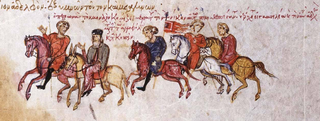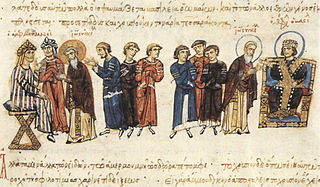
Photios I, also spelled Photius, was the ecumenical patriarch of Constantinople from 858 to 867 and from 877 to 886. He is recognized in the Eastern Orthodox Church as Saint Photios the Great.

Basil I, nicknamed "the Macedonian", was Byzantine emperor from 867 to 886. Born to a peasant family in Macedonia, he rose to prominence in the imperial court after gaining the favour of Emperor Michael III, whose mistress he married on his emperor's orders. In 866, Michael proclaimed him co-emperor. Fearing a loss of influence, Basil orchestrated Michael's assassination the next year and installed himself as sole ruler of the empire. He was the first ruler of the Macedonian dynasty.

Theophilos was Byzantine Emperor from 829 until his death in 842. He was the second emperor of the Amorian dynasty and the last emperor to support iconoclasm.

Leo VI, also known as Leothe Wise, was Byzantine Emperor from 886 to 912. The second ruler of the Macedonian dynasty, he was very well read, leading to his epithet. During his reign, the renaissance of letters, begun by his predecessor Basil I, continued; but the empire also saw several military defeats in the Balkans against Bulgaria and against the Arabs in Sicily and the Aegean. His reign also witnessed the formal discontinuation of several ancient Roman institutions, such as the separate office of Roman consul.

Bardas was a Byzantine noble and high-ranking minister. As the brother of Empress Theodora, he rose to high office under Theophilos. Although sidelined after Theophilos's death by Theodora and Theoktistos, in 855 he engineered Theoktistos's murder and became the de facto regent for his nephew, Michael III. Rising to the rank of Caesar, he was the effective ruler of the Byzantine Empire for ten years, a period which saw military success, renewed diplomatic and missionary activity, and an intellectual revival that heralded the Macedonian Renaissance. He was assassinated in 866 at the instigation of Michael III's new favourite, Basil the Macedonian, who a year later would usurp the throne for himself and install his own dynasty on the Byzantine throne.

Theodora, sometimes called Theodora the Armenian or Theodora the Blessed, was Byzantine empress as the wife of Byzantine emperor Theophilos from 830 to 842 and regent for the couple's young son Michael III, after the death of Theophilos, from 842 to 856. She is sometimes counted as an empress regnant, exercising power in her own right, rather than just a regent. Theodora is most famous for bringing an end to the second Byzantine Iconoclasm (814–843), an act for which she is recognized as a saint in the Eastern Orthodox Church. Though her reign saw the loss of most of Sicily and failure to retake Crete, Theodora's foreign policy was otherwise highly successful; by 856, the Byzantine Empire had gained the upper hand over both the Bulgarian Empire and the Abbasid Caliphate, and the Slavic tribes in the Peloponnese had been forced to pay tribute, all without decreasing the imperial gold reserve.

The Macedonian dynasty ruled the Byzantine Empire from 867 to 1056, following the Amorian dynasty. During this period, the Byzantine state reached its greatest extent since the Early Muslim conquests, and the Macedonian Renaissance in letters and arts began. The dynasty was named after its founder, Basil I the Macedonian who came from the theme of Macedonia.

EudokiaIngerina was a Byzantine empress as the wife of the Byzantine emperor Basil I, the mistress of his predecessor Michael III, and the mother of emperors Leo VI and Alexander, as well as the mother of Patriarch Stephen I of Constantinople.

Methodios I or Methodius I was Ecumenical Patriarch of Constantinople from March 4, 843 to June 14, 847. He was born in Syracuse and died in Constantinople. His feast day is celebrated on June 14 in both the East and the West.

Petronas was a notable Byzantine general and leading aristocrat during the mid-9th century. Petronas was a brother of Empress Theodora and hence brother-in-law of Emperor Theophilos, under whom he advanced to the high court rank of patrikios and the post of commander of the Vigla guard regiment. After Theophilos' death, he played a role in the ending of Iconoclasm, but was sidelined along with his brother Bardas during the minority of his nephew, Michael III, when power was held by the regent Theoktistos. In 855, Petronas and Bardas encouraged Michael III to seize control of the government: Theoktistos was murdered, Theodora banished to a monastery, Bardas became Michael's chief minister, and Petronas was tasked with the war against the Arabs. In 863, he scored a crushing victory at the Battle of Lalakaon, a feat which marked the gradual beginning of a Byzantine counter-offensive in the East. Promoted to the rank of magistros and the office of Domestic of the Schools, he died in 865.

Theoktistos or Theoctistus was a leading Byzantine official during the second quarter of the 9th century and the de facto head of the regency for the underage emperor Michael III from 842 until his dismissal and murder in 855. A eunuch courtier, he assisted in the ascent of Michael II to the throne in 820, and was rewarded with the titles of patrikios and later magistros. He held the high posts of chartoularios tou kanikleiou and logothetēs tou dromou under Michael and his son Theophilos. After Theophilos' death in 842, Theoktistos became a member of the regency council, but soon managed to sideline the other members and establish himself as the virtual ruler of the Empire. Noted for his administrative and political competence, Theoktistos played a major role in ending the Byzantine Iconoclasm, and fostered the ongoing renaissance in education within the Empire. He also continued the persecution of the Paulician sect, but had mixed success in the wars against the Arabs. When Michael III came of age in 855, his uncle Bardas persuaded him to throw off the tutelage of Theoktistos and his mother, the Empress-dowager Theodora, and on 20 November 855, Theoktistos was assassinated by Bardas and his followers.

The Photian Schism was a four-year (863–867) schism between the episcopal sees of Rome and Constantinople. The issue centred on the right of the Byzantine Emperor to depose and appoint a patriarch without approval from the papacy.

John VII, surnamed Grammatikos or Grammaticus, i.e., "the Grammarian", was Ecumenical Patriarch of Constantinople from January 21, 837 to March 4, 843, died before 867. He is not to be confused with the much earlier philosopher John Philoponos.
Stylianos Zaoutzes was a high Byzantine official of Armenian origin. Rising to high rank under Byzantine emperor Basil I, he then rose further to prominence under Basil's successor Emperor Leo VI the Wise, who had a close friendship and possibly an affair with Stylianos's daughter Zoe Zaoutzaina. Stylianos Zaoutzes was Leo's leading minister during the first half of his reign, and was awarded the unique title of basileopator. His standing and influence declined after 895, but in 898, he became Leo's father-in-law when the Byzantine emperor married Zoe. He died in 899, in the same year as Zoe. Following an attempted coup by his relatives, the Zaoutzes clan was deprived of the considerable power it had amassed under Stylianos's tutelage.
Manuel the Armenian, was a prominent Byzantine general of Armenian origin, active from c. 810 until his death. After reaching the highest military ranks, a palace conspiracy forced him to seek refuge in the Abbasid court in 829. He returned to Byzantine service the next year, receiving the position of Domestic of the Schools from Emperor Theophilos, who had married his niece Theodora. Manuel remained in the post throughout Theophilos's reign, and reportedly saved the emperor's life in the Battle of Anzen in 838. According to one report, he died on 27 July 838 of wounds received during the battle, but other sources record his survival past this date, ascribing him a major role in the regency that governed the empire after Theophilos's death, and report that he died some time around 860.
Constantine Maniakes was a senior Byzantine court official of the mid-9th century.

Thekla, Latinized as Thecla, was a princess of the Amorian dynasty of the Byzantine Empire. The eldest child of Byzantine emperor Theophilos and empress Theodora, she was proclaimed augusta in the late 830s. After Theophilos's death in 842 and her mother becoming regent for Thekla's younger brother, Michael III, Thekla was associated with the regime as co-empress alongside Theodora and Michael.

Constantine was a junior Byzantine emperor, alongside Basil I as the senior emperor, from January 868 to 3 September 879. His parentage is a matter of debate, but historians generally assume him to be the son of Emperor Basil I and his first wife Maria or second wife Eudokia Ingerina; other theories include him being the son of Emperor Michael III and Eudokia. Constantine was made co-emperor by Basil in c. January 868. He was engaged to Ermengard of Italy, the daughter of Holy Roman Emperor Louis II, in 870/871, but it is not known if he married her; some sources suggest he did, and others argue that there is no concrete evidence.

The Amorian dynasty ruled the Byzantine Empire from 820 to 867. The Amorian dynasty continued the policy of restored iconoclasm started by the previous non-dynastic emperor Leo V in 813, until its abolition by Empress Theodora with the help of Patriarch Methodios in 842. The continued iconoclasm further worsened relations between the East and the West, which were already bad following the papal coronations of a rival line of "Roman Emperors" beginning with Charlemagne in 800. Relations worsened even further during the so-called Photian Schism, when Pope Nicholas I challenged Photios' elevation to the patriarchate. However, the era also saw a revival in intellectual activity which was marked by the end of iconoclasm under Michael III, which contributed to the upcoming Macedonian Renaissance.

The Council of Constantinople of 843 or the Synod of Constantinople of 843 was a local council of Christian bishops that was convened in Constantinople in AD 843 by the Byzantine regent Theodora to confirm iconophilism in the Church. This council is still celebrated on the first Sunday of Great Lent in the Eastern Orthodox Church, as presecribed by the council. After the council which was under the presidency of the Patriarch Methodios I, the attendees met on 11 March 843 and symbolically processed from the Blachernae Church to the Church of Hagia Sophia bearing an icon of the Mother of God.




























